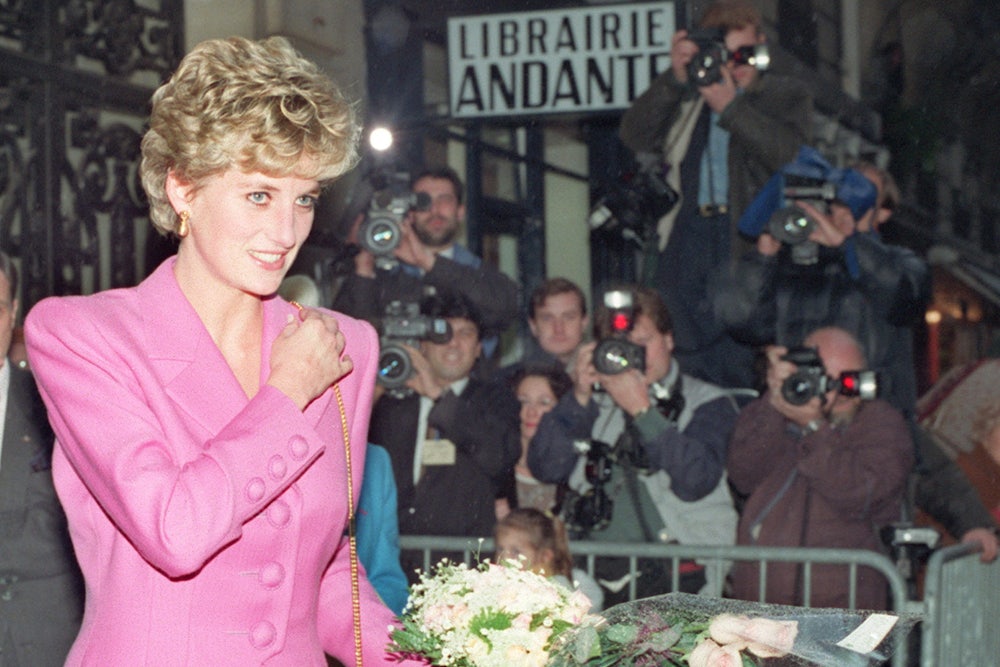Next week marks the 20th anniversary of the death of Diana, Princess of Wales. I know that she died on a Sunday because we piled into my parents’ bed to watch it on the news. I also remember someone’s mother berating me for making jokes about her death at a birthday party. The injustice of it still smarts: I knew as well as everybody else did that the week before every middle-class mother in the land had thought she was a slut. I read it in the paper! How times change.
Take the lede from this piece from the Herald Scotland, published in September of 1995:
MARRIAGE wrecker, femme fatale, a blonde Venus flytrap who consumes men like insects—Princess Diana can do nothing right these days. Once the darling of the tabloid press, fashion role model, devoted mother, saintly visitor to the Aids ward, innocent victim of an arrogant husband besotted with his ageing, plain (the worst sin of all, given a bride the world found desirable), married mistress, she has now been recast.
The total about-face of the British tabloid press in the wake of Diana’s death was and remains scandalous. The same papers who canonized her in death had in the final months of her life blamed Diana for Dodi al Fayed’s jilting of his girlfriend Kelly Fisher and painted her as a voracious harpy. This long pattern of harassment went back to 1992, when The Sun newspaper published a piece called “Squidgygate.” The piece transcribed a private conversation between Diana and her friend James Gilbey, in which he called her “Squidgy” as a nickname and she referred to life with Charles as “real torture.” (The phonecall was recorded by a man who listened in to non-commercial radio frequencies for fun.)
After Diana died, the press had to retract every note of satire or judgment from their accounts of her life. The result was coverage saturated by sentimentality, expressing nothing but dull earnestness. The Sun’s headline read: “GOODNIGHT OUR SWEET PRINCESS.” The Greek newspaper Apogevmatini, meanwhile, went with the extraordinary outlier headline, “Lady D(ead).”
In life, Diana courted this kind of sentimentality. She famously spoke of wishing to be the “Queen of people’s hearts,” rather than the Queen of the actual country—a duty she had foregone by divorcing the husband she loathed. Her charity work and somewhat Mother Theresa-like willingness to be photographed with the sick and the poor (and Mother Theresa) was a valuable use of her high visibility, but not a complex one. So, Diana did not have much nuance to lose, but in death she lost her personality. She became a commemorative plate rather than a person.
When the conversation around a person or idea is so suffocatingly earnest that there is no space for irony, it becomes ridiculous. So, Diana is a joke on the internet now. Explaining a joke is a painful and unpleasant way to kill it, but the nature of Diana-humor online is worth considering since it is a second indictment of the media coverage of her that went before, as well as a celebratory reclamation of her lost humanity.
A few years ago, a friend brought the extraordinary Twitter account “Diana Day by Day” to my attention. With a sincerity of tone to match the Cincinnati Zoo, the account tweets the events of Diana’s life in “real time,” up until the moment of her death, each year. So, since on August 24 1997 Diana was photographed in a yellow swimsuit on a boat, Diana Day by Day tweets those photographs on August 24:
24 August 1997
— Diana Day by Day (@DianaDaybyDay) August 24, 2017
Some photos from today. pic.twitter.com/4waOtM43G3#Diana20
The appeal of Diana Day by Day is in its mixture of sincerity, its unselfconsciousness, its cyclical, yearly murder of the People’s Princess, and the gorgeous 1990s-ness of Diana’s outfits. It’s all amplified by the way in which Diana herself also exhibited those qualities in spades.

Diana was funny and theatrical in life, embracing her rejection of lifelong heterosexual marriage in a way that has made her a lodestar for alienated people everywhere. She’s the ultimate victim of the ultimate patriarchal establishment—a literal monarchy—and, all the better, she’s a gorgeous princess. It doesn’t hurt that she was best friends with Elton John, Kenny Everett, and Freddy Mercury, arguably the only gay celebrities in Britain at the time. (These last two once snuck her out to a club in drag.)
The humor of the internet is both camp and something more than camp: being not really connected to the marginal in society, it has the space to become truly surreal.
And the tweets of Diana Day by Day are truly surreal. The idea that Diana could become trapped in an endless reenactment of her final year on earth, boiled down to the rigid prose of an obsessive fan account, is funny as hell. Meanwhile Diana’s beauty and her fashion—which so precisely matches the styles of our own moment—seem to leap out of 1997 and into our own lookbooks.
That Diana as a symbol for women’s alienation (from marriage, from authoritative institutions, from one’s own good reputation) thrives now is an unexpected blessing. And fandom on the internet keeps an aspect of her personality and sense of humor alive.
According to legend, Prince Phillip, the Queen’s husband, once said of Diana that at least she would “breed some height” into the family. This remark was typical. She was treated like dirt by her in-laws and she was treated like dirt by the press. If the final vengeance of a screen icon is in the soundbites that live in posterity, then Diana has trounced the media in death in a way that she never could in life. As the Times reported in 1991, she was once surprised by photographers as she sat behind the wheel of her Mini Metro. “I know it’s just a job they have to do,” she said, “but sometimes I do wish they wouldn’t.”
